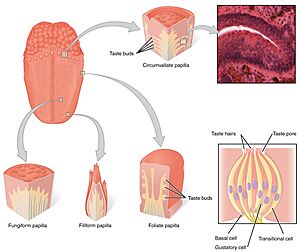Taste bud facts for kids
Quick facts for kids Taste buds |
|
|---|---|
 |
|
| Taste buds are small structures present within the papillae of the tongue | |
| Latin | caliculus gustatererius |
| System | Taste |
Taste buds are tiny sensory organs found mostly on your tongue. They are like special detectors that help you figure out the different tastes of food and drinks you put in your mouth. These amazing little bumps help you enjoy your favorite snacks and also warn you if something tastes bad or might be spoiled.
There are five main tastes that your taste buds can detect: salty, sour, bitter, sweet, and umami. Each of these tastes plays a part in how you experience food.
Contents
What Are Taste Buds?
Taste buds are very small, oval-shaped groups of cells. They are mostly located on the surface of your tongue, but you can also find some in other parts of your mouth, like the soft palate (the back part of the roof of your mouth) and the epiglottis (a flap that covers your windpipe when you swallow).
Most of the taste buds are hidden inside tiny bumps on your tongue called papillae. These papillae are what give your tongue its rough texture. Not all papillae have taste buds, but many do!
Types of Papillae
Your tongue has different kinds of papillae, and some of them are home to taste buds:
- Fungiform papillae: These are mushroom-shaped and found mostly on the tip and sides of your tongue. They contain taste buds.
- Circumvallate papillae: These are large, round bumps located at the back of your tongue, forming a V-shape. They have many taste buds.
- Foliate papillae: These are folds or ridges on the sides of your tongue, near the back. They also contain taste buds.
- Filiform papillae: These are the most common type, covering most of your tongue. They are thin and cone-shaped, but they do not contain taste buds. They help you feel the texture of food.
How Taste Buds Work
Each taste bud is made up of 50 to 100 special cells called taste receptor cells. When you eat or drink something, chemicals from the food mix with your saliva. These chemicals then enter tiny pores on the surface of your tongue, called taste pores, and reach the taste receptor cells.
When the chemicals touch these cells, they send signals to your brain through nerves. Your brain then figures out what taste you are experiencing. This whole process happens incredibly fast, allowing you to taste food almost instantly!
The Five Basic Tastes
Your taste buds work together to identify the different tastes:
- Sweet: This taste often tells you that food contains sugar, which is a source of energy. Think of candy, fruit, or honey.
- Sour: This taste is usually found in acidic foods, like lemons or vinegar. A little sourness can be refreshing, but too much might signal that food is unripe or spoiled.
- Salty: This taste comes from salts, like the one you use in cooking. Salt is important for your body's functions.
- Bitter: This taste can sometimes warn you about harmful or poisonous substances, as many toxins are bitter. However, many healthy foods like coffee or dark chocolate also have a pleasant bitterness.
- Umami: This is a savory, meaty, or brothy taste. It's often found in foods like mushrooms, cheese, tomatoes, and cooked meats. Umami signals that food contains proteins, which are essential for your body.
Why Taste is Important
Taste is not just about enjoying your food. It also plays a vital role in your health and safety.
- Nutrition: Taste helps you choose foods that provide the nutrients your body needs. For example, the sweet taste attracts you to energy-rich foods.
- Safety: Your taste buds can help protect you from eating spoiled or harmful foods. A very sour or bitter taste might make you spit out something that could make you sick.
- Digestion: The act of tasting food can also start the digestive process, preparing your stomach to receive and break down what you've eaten.
Your sense of taste works closely with your sense of smell. When you have a stuffy nose, food might seem to have less flavor because your smell receptors can't help your brain fully identify the food.
See also
In Spanish: Papilas gustativas para niños


